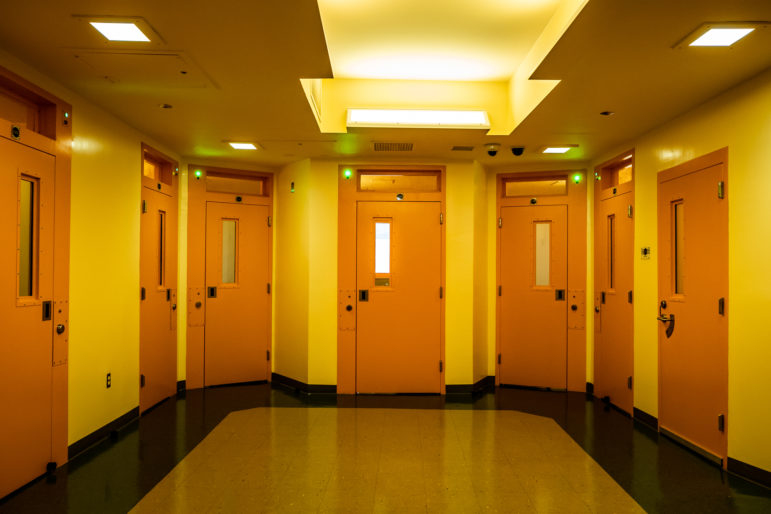
Adi Talwar
Inside the Crossroads Juvenile Center, in Brownsville, Brooklyn. The facility is similar to the Horizon center in the Bronx where 16- and 17-year-olds previously held at Rikers are being transferred.As COVID-19 rages through the United States, experts have agreed that incarcerated people are at particular risk of infection and death due to the close quarters, restricted freedom of movement, and lack of resources in jails and prisons. In late March, New York Governor Andrew Cuomo committed to releasing some 1,100 adults held on violations of probation. While many juveniles are likewise detained for violations of probation and nonviolent offenses, similar grace was not extended to them by Mayor de Blasio, whose Administration for Children’s Services maintains the city’s juvenile detention centers.
Cuomo continues to face pressure to release more adults from prison from public defenders, District Attorneys, and correctional facility oversight bodies alike. All urge Cuomo to consider, among other things, the risk to aging populations and other vulnerable adult groups in our state’s prisons and jails, leaving the kids, de Blasio’s purview, behind once again.
As third-year students in the Juvenile Defender Clinic at New York University School of Law, we represent young people accused of crimes in New York Family Court delinquency proceedings. Many of our clients are currently held in juvenile detention centers across the city; some are held pending trial, presumed innocent of any wrongdoing. We write to express our concern over the city’s failure to sufficiently address the health risks faced by our clients in detention, and we call upon the mayor to release all juvenile detainees immediately.
Despite misconceptions about young people’s low risk of contracting COVID-19, children can in fact become infected, and several children across the country have already died of the virus. Kids in juvenile detention have greater incidence of pre-existing conditions, such as diabetes or asthma, compared to their peers at liberty, which can place them at higher risk of becoming seriously ill should they contract COVID-19. Further, in major cities throughout the United States, people of color are dying at dramatically higher rates than their white counterparts: in New York City, COVID-19 has been shown to be twice as deadly for Black and Latino residents as White residents. New York’s juvenile detention system is rife with racial disparities—in 2018, every single child detained in a limited secure detention facility (the intermediate level of security in the city’s juvenile detention scheme) was a person of color, and the system continues to reflect a similar racial makeup today. As the pandemic continues to disparately ravage Black and brown communities, which suffer disproportionately from poverty, lack of access to health care, and pre-existing conditions, children of color—locked away from family and friends—are at risk of illness and even death, unless drastic executive action is taken.
The city’s efforts to date to curtail the spread of the virus in juvenile detention are insufficient. Crossroads Juvenile Center, which is typically used as the city’s secure juvenile detention center for thirteen- to fifteen-year-olds, is currently being used to house detained youth who do not show symptoms of COVID-19. Those who are symptomatic are placed at Horizon Juvenile Center, which typically houses sixteen- to eighteen-year-olds. The virus can be spread by people who are asymptomatic or presymptomatic, making this separation potentially futile. Further, children in custody may not notice or willingly report symptoms out of fear of repercussion or social isolation. This attempted system of separation necessarily relies on the ability of correctional staff to make accurate medical diagnoses that can only be made by medical professionals, thereby putting all detained children at risk.
 CityViews are readers’ opinions, not those of City Limits. Add your voice today!
CityViews are readers’ opinions, not those of City Limits. Add your voice today!
Juvenile detention even under normal conditions presents a serious safety risk to juveniles, who experience shocking rates of incidents of disciplinary force while detained. The existing risk to detained children’s physical safety may be exacerbated by holding younger children with older teens from whom they would normally be separated. Indeed, after moving to the new detention system, a brawl involving eight children and thirty staff broke out at Crossroads Juvenile Center in Brooklyn last weekend. If the increased risk to children’s wellbeing while in custody due to physical injury were not enough, there have been multiple confirmed cases of COVID-19 among Crossroads staff, exposing the very youth intended to be kept healthy and safe by the reorganization of detention facilities.
Mayor de Blasio, it is not possible to detain youth, or people of any age, without heightening their risk of contracting this potentially deadly disease. It is dangerously naive to continue to keep kids behind bars under the misperception that they are not at risk of serious illness. It’s time to free the kids.
Whitney Braunstein, Joy Chen, Jenna Hymowitz, Rupa Subramaniam, Cathleen Lisk, Alexa Wheeler, Marlena Santos, Kevin Tanaka, David Altman, Keiler Beers, Efosa Akenzua, and McKay Campbell are third-year students in the Juvenile Defender Clinic at NYU School of Law.








